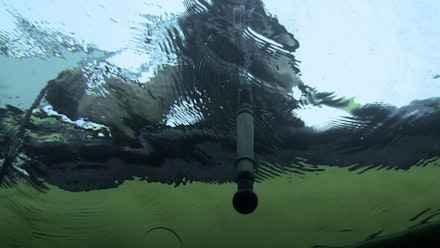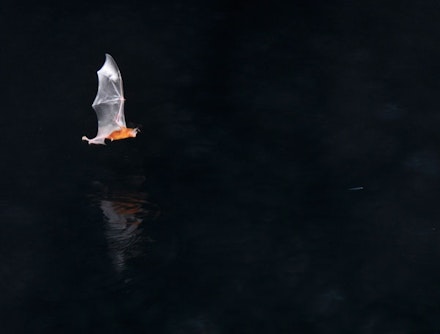JANA WINDEREN is an artist educated in Fine Art at Goldsmiths College in London, and with a background in mathematics, chemistry, and fish ecology from the University in Oslo. Winderen researches the hidden depths with the latest technology; her work reveals the complexity and strangeness of the unseen world beneath. The audio topography of the oceans and the depth of ice crevasses are brought to the surface. She is concerned with finding and revealing sounds from hidden sources, both inaudible for the human senses and sounds from places and creatures difficult to access. www.janawinderen.com
What new or old tools are you
attached to in your art practice?
The most important instruments for any artist working with sound are their ears and the ability to learn how to listen and develop their relationship with the world around them.

For each project there would be a different approach, so I carefully select what is needed to tell the story by researching the location through site visits, talking to local people and scientists, photographing, and so on. Very often the project will change according to findings at the site and stories I am told.

What particularly interests me are the sounds which cannot be perceived without help from specific tools, such as instruments which help me hear what other creatures can hear, but humans cannot. A good example of this is the very sensitive hydrophones with long cables that can reach deep into ice crevasses, into the ocean or a lake or a river, and on land inside an ants’ nest or a tree. Another tool I use a lot is the Pettersson Ultrasound Detector, which enables me to record ultrasound (sound that lies above the range of human hearing). Later I can time-expand it 10 or 20 times into our audible frequency range. (As humans we can “only” hear between 20 – 20000 Hz). I can also listen to bats echolocating in real time through frequency division out there in the field, so even if you do not see the bats, you can hear them all around. Using this amazing device I can listen to and record bats and other creatures that use frequencies outside our hearing range.
I use recording devices of the highest quality to be able to get the high resolution I need and to get as good recordings as possible of the smallest animals, such as underwater insects, or a worm eating a leaf, or ants crawling around in an ants’ nest, or a beetle nibbling on a tree. Through thorough and careful listening, and then by amplifying the small and most inaccessible sounds, I hope to reveal the complexity of the environment. I walk around with “a magnifying glass for sound” in the same way I also use a macro lens for photography.
Though sound is immaterial, there are still very physical aspects to the work—in the recording session, usually outside in the environment. It is often cold. I might have heavy bags to carry, and you need to be prepared to function in sometimes quite extreme conditions. You sense the temperature, the dryness, the rain, or the strong winds. Without being prepared for the conditions, it is impossible to listen, observe, and concentrate over a long time. You cannot be impatient. If I get impatient there is no longer any point in recording.

I remember once I tried to make an Anoplotrupes stercorosus pose for my macro lens by moving the beetle around with my large, brutal hand. Of course it got scared and tried to dig itself into the earth. You have to take a deep breath, be patient, and wait with respect and humility. It was waving its head from side to side, in a rhythm, probably as a defense—I will ask a beetle expert—or even ask the beetle itself by repeated observation, at a respectful distance. They have been on the planet so much longer than us. When recording sound from the very small creatures, it is all the same, it takes time to get in tune with the very
small creatures.
Don’t forget! Pen and paper. I use them all the time.
What tools have you rejected?
Rather than saying I have rejected tools, I have rejected the making of objects, which take up space. I use speakers, they are objects, sure—but I reuse them. I also reuse the recording tools, and the pieces I make are intangible. They are made by moving air and someone listening and feeling the frequencies. I will never forget a concert by BJNilsen that made my nostrils vibrate, and as a result of another frequency he played my vocal cords vibrated, which gave me a quaking voice. It was very physical, but only carried in my memory, and it cannot be sold. This also applies to the emotions that swell up and burst every time I listen to Philip Jeck’s live performances. Sounds can trigger an emotional response of memories and associations. Sound is all around you. But it would be wrong to say that I have rejected all the tools which have to do with physical object-making, since every sound installation I make is in a physical space, and the speakers are also placed in a visual and physical composition—if I want them to be visible. From my visual art background I have training in drawing and visual composition. These are good skills to have.
What have the tools done to your art?
The recording unit (and various microphones, hydrophones, and ultrasound detectors) reveals to me exciting new discoveries every recording session I undertake and grants me access to worlds otherwise inaudible. It opens up new areas, which lead me to connecting with engineers and scientists I otherwise would not have met, and I get experience with the tools scientists are using. I am after the best sound quality and highest definition possible in the recordings, and this can be shared with the scientists who are often more interested in the visual representation of their recordings than the sound quality, it seems. I think there is a lot more information to get also through very high quality recordings and focused listening.

My very nerdy interest and years of experience brings me to distant places on the planet and keeps my curiosity alive, and hopefully it can inspire others. I see that my art moves closer to science and research, though I still have the freedom as an artist to keep asking questions and never be forced to come up with answers—all the time asking more questions.As a result of this approach, it takes me back to where I came from as a child, and my lifelong attachment to the ocean and its ecosystems and all the unanswered questions, here on our beautiful blue planet.